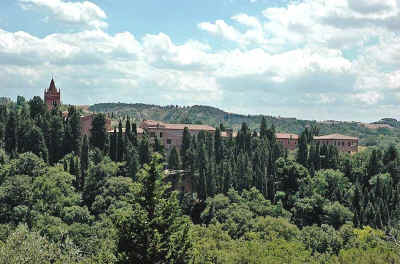
|
The
Abbey of Monte Oliveto Maggiore is located 36 km south of Sienna in the characteristic "badlands" landscape of the
Crete Senesi. The Olivetan community traces its foundation to 1313 and Giovanni Tolomei - who took the religious name of Bernardo - along with two of his friends, from the noble families of
Sienna, Patrizio Patrizi and Ambrogio Piccolomini. |
|
|
The Abbey is situated 273 m above sea level at Chiusura, not far from Asciano in the province of Sienna, surrounded by the thick forest that overlooks the Crete Senesi countryside below. The approval for the building of the monastery came with the "Charta fundationis" by Guido Tarlati, bishop of Arezzo (26 March 1319), and the monastery took the name of Monte Oliveto «Maggiore» (Major) so as to distinguish it from successive foundations (Florence, San Gimignano, Naples, etc.). Construction of the monastery began in 1393 and was completed in 1526, although the buildings were further modified during the Renaissance and the Baroque periods.
An imposing square tower with a drawbridge that was part of the original defences erected to protect the entire
complex stands at the entrance to the Abbey. The courtyard of the abbey opens onto a broad avenue of cypresses. To the left is the botanical garden that supplied medicinal plants
for the monks. A little further on is the fish pond designed in 1553 by Pelori and used by the monks to provide fish at those times of year during which the Benedictine rule forbade the consumption of meat. The abbey has three 15 C cloisters, of which the most magnificent is the rectangular Chiostro Grande, constructed between 1426 and 1443. It is made up of two passages, one above the other, supported by columns. The portico is decorated with a fresco cycle by Luca Signorelli depicting the life of St Benedict, who began work on its 36 large scenes in 1497. The cycle was finished in 1508 by Sodoma. The Chiostro Centrale is composed of a portico that rests on polygonal columns that lead to the magnificent Refectory, decorated with frescoes by Fra’ Paolo Novelli. The Monastic Library of Monte Oliveto
The abbey’s large Library comprises more than 40,000 volumes, pamphlets and parchments that have been carefully restored by the monks. The Library leads to the Pharmacy, which contains an important collection of 18 C spice vases. The abbey still produces honey and distilled herbal spirits made according to various ancient recipes. The Dispensary
The dispensary of the monastery was active until 1865. Its rich collection of pharmaceutical jars is housed in the room above the monumental library and consists of 17 C and 18 C ceramics originating from the furnaces of San Quirico d'Orcia. Gregorian Chant at Monte Oliveto
Many visitors come to the Abbey of Monte Oliveto to hear the Gregorian chant sung by the monks. At Monte
Oliveto, as in many other Benedictine monasteries, they are part of the
conventual mass, at Vespers, at Compline and, in part, at Lauds. |
Travel Guide for Visitors to the Chianti Classico Wine Region of Tuscany, Italy.
Abbazia di Monte Oliveto Maggiore in italiano
Monte Oliveto © ammonet InfoTech 2006 - 2021. All rights reserved.